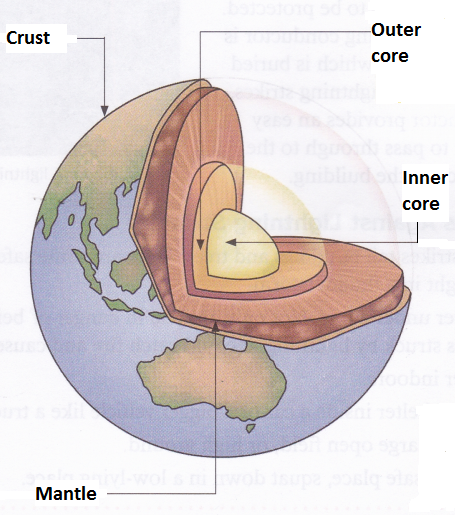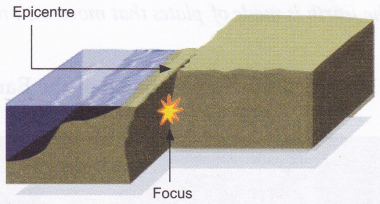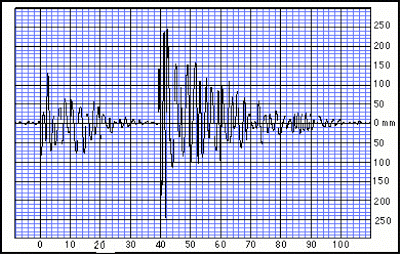What is the Source of the Earthquake
Earthquake is another destructive natural phenomenon. To be able to understand what an earthquake is, we need to understand the internal structure of the Earth.

- Crust is the thin outer covering of the Earth. The crust is thinner at the ocean floor (about 6-11 km) than under the continents (about 30-70 km).
- Outer core is about 2300 km thick. It is believed to contain iron and nickel in a molten state. There is also some sulphur present here
- Inner core is about 1200 km thick. It is believed to be composed almost entirely of solid iron.
- Mantle is the layer immediately beneath the crust. It is about 2900 km thick and consists of semisolid rock, iron, magnesium, and calcium.
An earthquake is a sudden movement or a fracture in the crust and the upper layer of the mantle (together called the lithosphere). Earthquakes may range from mild tremors that can barely be felt to massive ones resulting in widespread destruction. The branch of science concerned with earthquakes and related phenomena is called seismology. Let us now discuss how the structure of the lithosphere is responsible for earthquakes.
Plate Tectonics
Earth’s lithosphere is not one continuous piece, but is broken into many pieces called plates. The Earth is divided into seven large plates and several smaller plates. Due to the slow movements inside the Earth (called convection currents), these plates move with respect to one another by about a few inches every year. This movement of plates results in earthquakes, volcanic eruptions, mountain formation, etc.
The theory that the surface of the Earth is made of plates that move with respect to one another is called plate tectonics.
Figure shows the seven large plates that cover much of the Earth’s surface.

How an Earthquake Occurs
Earthquakes generally occur at plate boundaries (also called seismic zones or fault zones). Here is a simplified description of how an earthquake happens.
1.The plates rub against each other as they move. Sometimes, the jagged edges of two plates get locked into each other and prevent them from moving. As a result, pressure builds up against these rough edges.
 2. As the pressure build-up continues, the edges give way. The resulting sudden movement of the plates causes an earthquake.
2. As the pressure build-up continues, the edges give way. The resulting sudden movement of the plates causes an earthquake.

The point where the edges give way is called the focus. The point vertically above the focus on the surface of the Earth is called the epicentre.
3. Vibrations caused by an earthquake travel in the form of waves within the Earth or along the surface of the Earth. These waves are called seismic waves.

Measurement of Seismic Waves
The instrument used to measure seismic waves is called a seismograph. A typical seismological output, called a seismogram, looks like a series of waves as shown in Figure. Scientists who study the behaviour of earthquakes are called seismologists.

How Does a Seismograph Work?
A seismograph consists of a mass (like a ball) suspended with a string. This ball has a little pen attached to it, and the tip of the pen touches a sheet of paper (like a graph sheet) placed on a fixed base. When the Earth shakes, the fixed base also shakes (since it is fixed to the ground), and the suspended ball moves with respect to the fixed base. The pen tip records this movement on the sheet of paper. The output of the seismograph looks similar to the one shown in the Figure.

Magnitude of an Earthquake
The magnitude of an earthquake can be determined from data recorded by a seismograph. The most common scale used to measure the magnitude of an earthquake is the Richter scale. An earthquake of magnitude 2.0-4.0 on the Richter scale is not too damaging. One of magnitude 4-8 is Considered a moderate to severe earthquake. An earthquake of magnitude greater than 8-9 would be very severe. The location of the earthquake (i.e., if it is in a highly populated area or in a remote area) also determines the amount of damage it can cause to human beings and property. Earthquakes are generally followed by low-intensity quakes called aftershocks.
On 26 January 2001, there was a major earthquake of magnitude 7.6-8.1 in Gujarat. It resulted in the loss of more than 20,000 lives and severe loss of property. The earthquake that struck the Indo-Pakistan border on the morning of 8 October 2005 had a magnitude of 7.6. It is estimated that more than 50,000 people lost their lives due to this earthquake.
